System Requirements
The plan for our house was to combine an HRV or an ERV (for a continuous supply of fresh air), with a ductless mini split air source heat pump system for our ventilation, heating, and air conditioning needs. Almost all of the projects I had read about utilized this same combination, especially here in the US.
The only real debate, apart from specific brand options, was whether or not to utilize only one distribution head on our main floor, as opposed to installing multiple heads for a more ‘dialed-in’ level of comfort (e.g. in the basement or the bedrooms).
Our original builder had in our construction drawings one head in the kitchen/family room and one in the basement, which was pretty standard for a Passive House level project. It was, therefore, pretty shocking to find out that our second builder (there were two partners) and their HVAC subcontractor were suggesting a system that was grossly oversized for our needs. You can read about the details here: GBA: Oversized System
This was just one of many ‘red flags’ that convinced us to move on and GC the project ourselves. It’s also a reminder that old habits die hard, meaning even seasoned contractors, in any trade, need to be willing to learn new ideas and techniques if they want to truly be considered professionals and craftsmen — unfortunately, they’re the exception to the rule, at least in our experience.
One of the disappointments associated with our build is, in fact, the disinterest (in some cases even outright hectoring contempt) shown by various tradespeople in our area for ‘green’ building generally. Doubtless, at least a partial explanation for why much of the Midwest seems so far behind in adopting ‘green’ building techniques, especially when it comes to air sealing, insulation, and IAQ beyond code minimum standards. Hopefully this changes significantly in the coming years.
Consequently, I took Steve Knapp’s advice (from the comments section of my question) and contacted Home Energy Partners (their new name: HVAC Design Pros). Isaac responded quickly and eventually did our Manual J, confirming we needed a much smaller system, one that is more consistent with a Passive House project, or even just a high-performance build more generally.
Here are a couple of Matt Risinger videos detailing a mini split set-up that’s fairly typical for a Passive House or a Pretty Good House (GBA article on the 2.0 version).
Once we were on our own, in addition to going with a Zehnder ERV and a Mitsubishi ductless mini split air-source heat pump system, we also pursued the possibility of using a Sanden heat pump water heater.
After seeing it used on a Hammer and Hand project, we thought it was a really interesting piece of cutting edge technology:
Unfortunately, after getting a quote from Greg of Sutor Heating and Cooling, and a poor response from Sanden regarding questions we had about the system (they were unresponsive to emails), we decided to stick with our Zehnder, the Mitsubishi heat pump, and then go with a Rheem heat pump water heater (going with the Rheem saved us just over $6,000 in initial cost). Hopefully, as it becomes more popular in the US, the Sanden can come down significantly in price, or maybe less expensive copycat products will someday show up on the market.
Greg was initially willing to work with us, even though we were technically out of his service area, when the Sanden was involved, but once it was only a ductless mini split he suggested we find a Mitsubishi Diamond installer closer to us, which we understood. He was nothing but professional, taking the time to answer any number of technical questions and offering what proved to be sage advice regarding various details for our system.
In fact, taking Greg’s advice, we contacted a Diamond installer close to us, but unfortunately the first installer we contacted disappeared when we were trying to get him to communicate with our electrician on installation details (an infuriating and painfully common experience when trying to build a new house — especially one with unconventional Passive House details).
Finding our Installer
At this point, we were lucky to find Mike from Compass Heating and Air. He came out to the job site and we walked through the details together. He proved to be knowledgeable, helpful, detail-oriented, and extremely professional. Installing our Mitsubishi ductless mini split system with Mike proved to be one of the easiest portions of our build. We never felt like we had to look over his shoulder, making sure he got details right, or that we had to constantly confirm that he did what he said he was going to do — in fact, it was the opposite: ‘Mike’s on site, so that’s one less thing I have to worry about’.
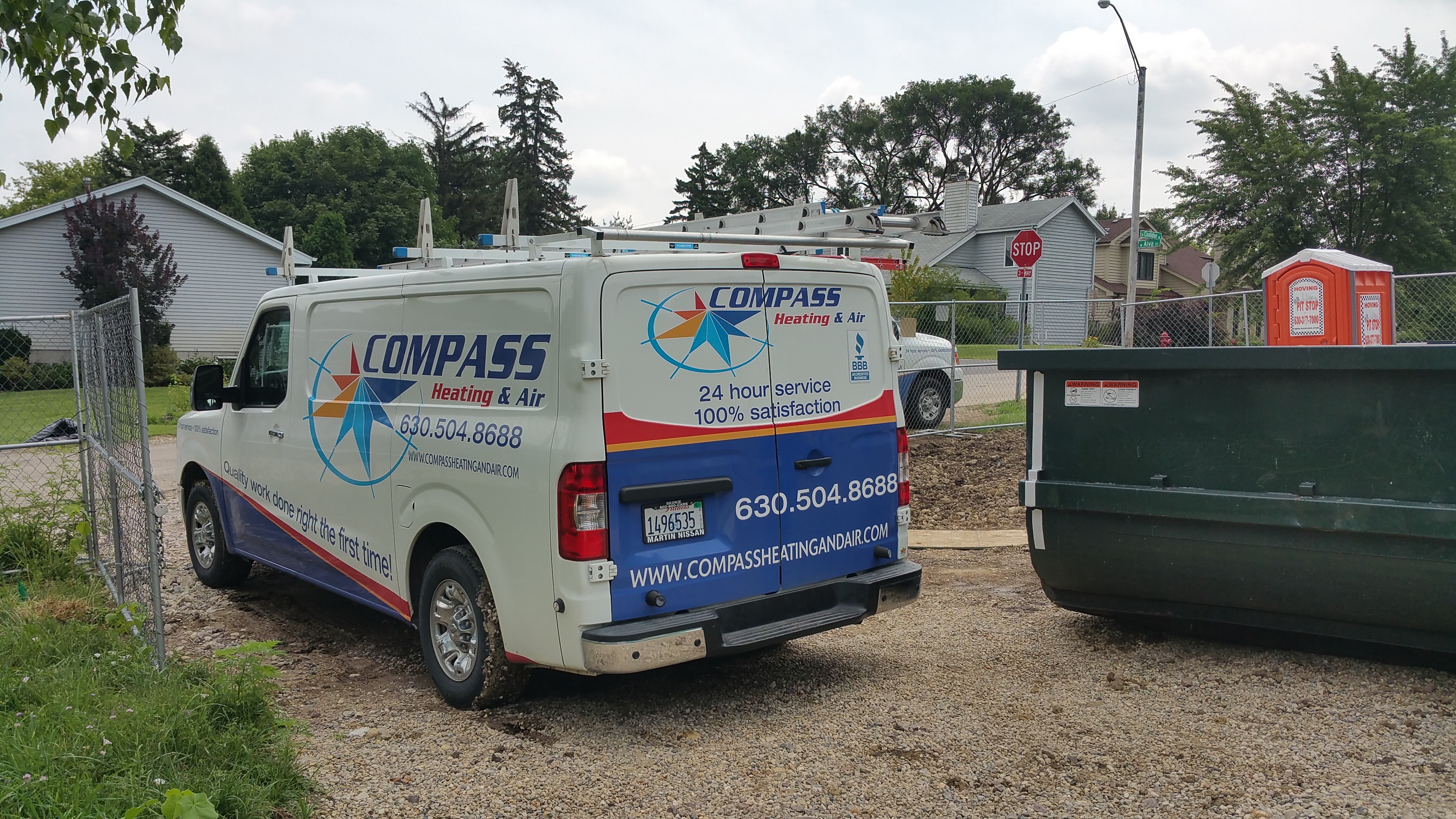
Mike also confirmed what Greg and Isaac also pointed out: comfort issues may develop if we tried to get by with just one distribution head on the main floor.
In fact, looking back through old emails, Greg was nice enough to walk me through some of the options employed by those trying to get by with a single head for an entire floor (sometimes even two floors), including leaving bedroom doors open throughout the day (ideally, even at night), and even the use of Tjernlund room-to-room ventilators.
Again, to his credit, Greg tried to stress how important it was that homeowners have realistic expectations regarding the overall effectiveness of these techniques and options.
He also was at pains to make clear how the work of any competent HVAC installer can be easily undermined by a structure that underperforms. In other words, they can design an appropriately sized HVAC system for a Passive House, but if shortcuts occur during the build and the final blower door number comes in higher than expected, or the budget for insulation gets cut (reducing R-values in the structure), then the system they designed has little chance of working as intended. Based on what he wrote, I’m guessing he has dealt with exactly this outcome in the real world — not fun for him, or the homeowners to be sure.
Consequently, by the time Mike from Compass Heating and Air got involved, we had pretty much already settled on using multiple heads. Although it was nice to hear the same consistent message from Greg, Isaac, and Mike in this regard.
In the end, we decided to delete the head in the basement, instead going with three separate heads on the main floor — the largest in the kitchen/family room, and then the other two would go in our bedrooms.
Here are the specs for our system:
Hyper-Heat Compressor (30,000 Btu)
MSZ-FH15NA (kitchen/family room)
MSZ-FH06NA (master bedroom)
MSZ-FH06NA (2nd BR)

Having the Zehnder supply diffusers on the same wall and near the head of the Mitsubishi has been working well for us. As far as we can tell, there are no discernible issues with this arrangement. By way of comparison, the Mitsubishi head and Zehnder supply diffuser are on separate walls in my daughter’s bedroom — in effect, they’re pushing air towards the center of the room from walls that are perpendicular to one another — but we still can’t tell any difference in terms of performance, either when heating or cooling.

Mike was also really good about communicating the system’s requirements to our electrician and our plumber. It was nice to watch all of them walk through the details together, thereby ensuring there were no problems once it came time to start up the individual heads.
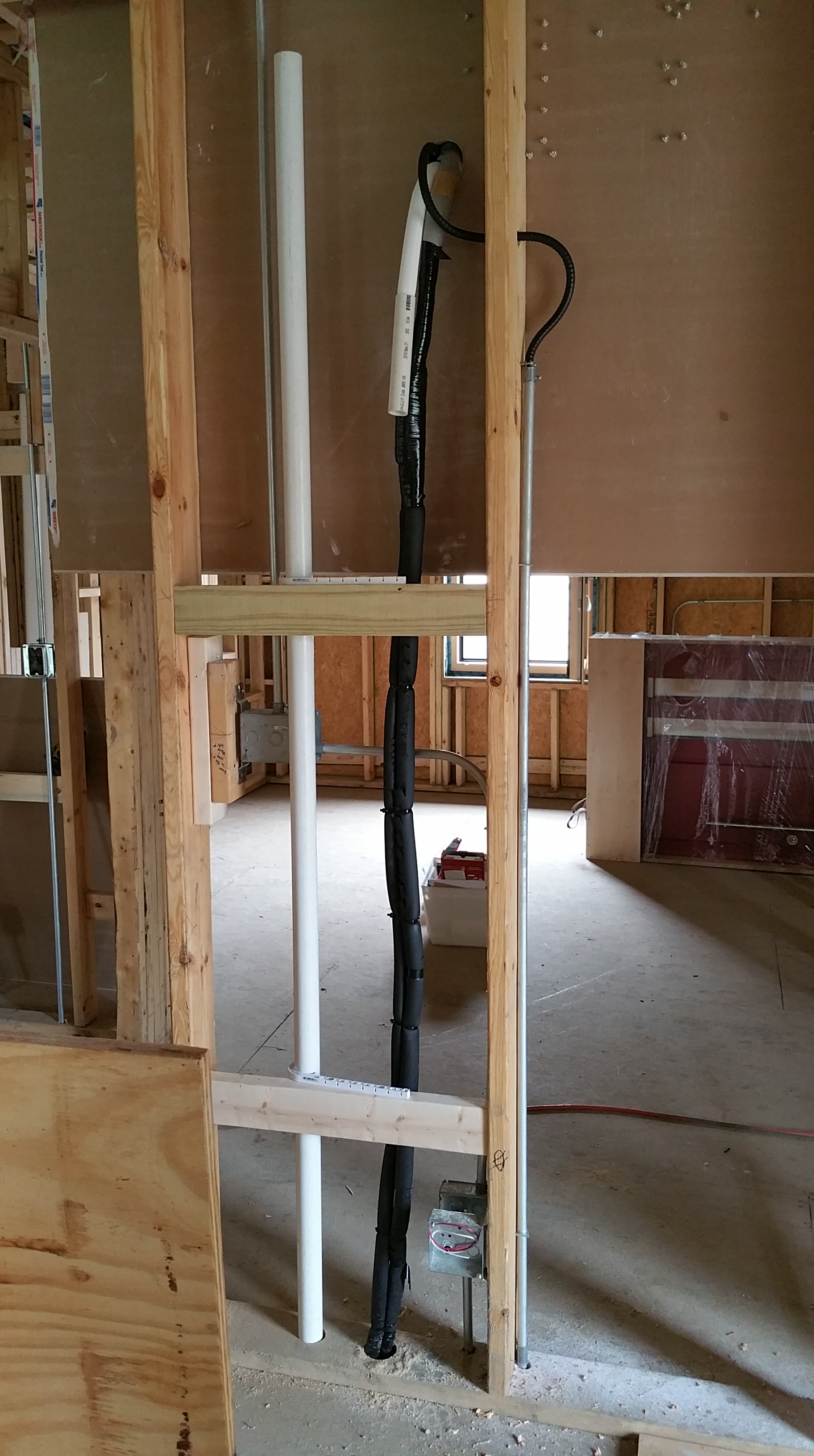
Living with a Ductless Mini Split
Having lived with the HVAC system, both the heat pump and ERV, for about a year now, our only real complaint is summer humidity, which I discussed in a previous post here: HVAC (1 of 2): Zehnder ERV
This summer we’re going to try using a dedicated, whole-house dehumidifier, which we think should resolve the issue.
Otherwise, our system has been trouble-free.
In winter, the heads do make some noise, tending to ‘crack’ or ‘pop’, especially when first turning on, or when they come out of defrost mode. Although I’ve read complaints about this online, it’s never really bothered us. I remember how loud our conventional gas-fired furnace was in our last house, especially when it first turned on, so I think it’s important to remember the level of certain sounds in their appropriate context.
Also, this ‘crack’ or ‘pop’ sound is, I suspect, louder than it otherwise would be, say in a conventionally built home, since Passive Houses are known to be significantly quieter because of all the air sealing and, in particular, all of the insulation surrounding the structure.
There’s also a noticeable humming sound when the compressor is going through a defrost cycle (especially noticeable at night when the house is otherwise quiet). The heads also temporarily send out cooler air during this defrost cycle, but the cycle is short enough that it hasn’t posed any real comfort issue for us.
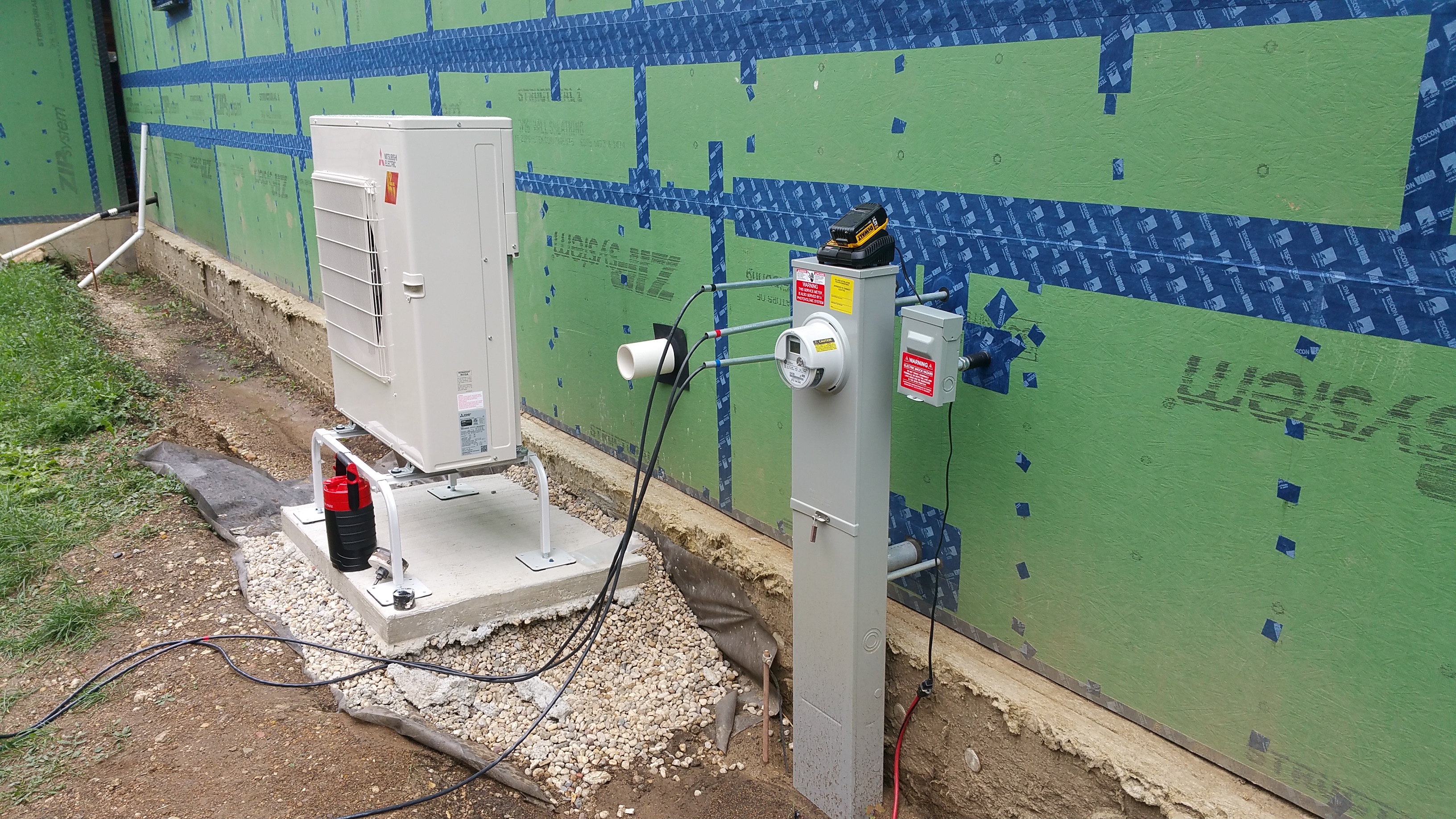
Regarding interior noise generally, the same holds true even for our refrigerator in the kitchen. We virtually never noticed the fridge in our last house when it was cycling, but in our Passive House it’s arguably the loudest, most consistent noise in the house, especially at night, or if quietly sitting and reading. Again, it took some getting used to, but not really that big of a deal.
In other words, having blocked out, or at least muffled, most of the noise from outdoors (due to extensive air sealing and extensive insulation), any noise indoors becomes much more noticeable and pronounced. The Rockwool we installed between bedrooms-bathrooms, and the kitchen-utility room for sound attenuation definitely helps in this regard (more on this in a later post).
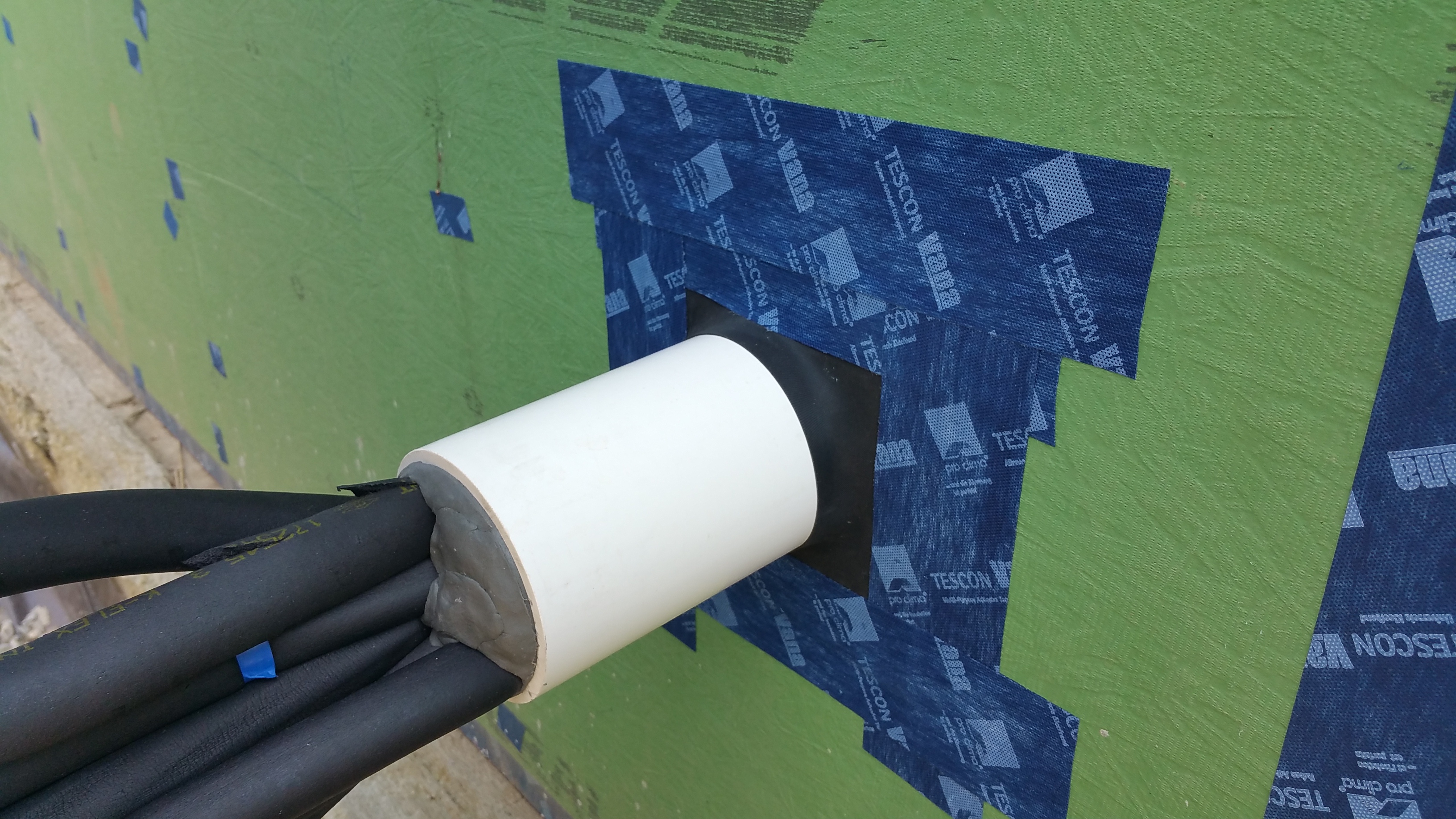
Just how quiet is a Passive House? Well, one example would be the train tracks that are just a couple of blocks away: When the windows are closed the noise from a passing train is mostly cancelled out — as opposed to when the windows are open, and the train, in contrast, sounds like it’s thundering through our next door neighbor’s yard.
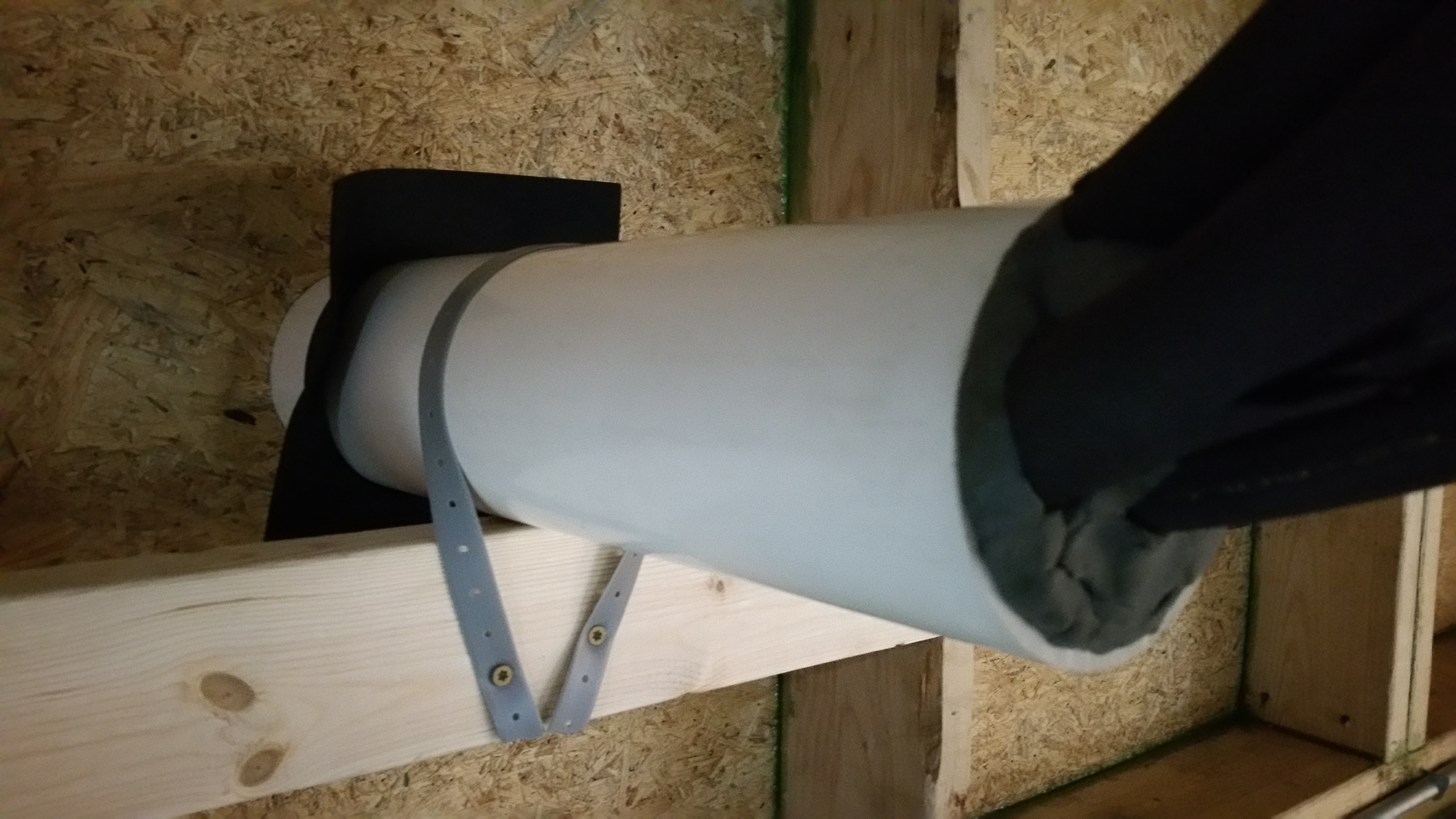
As far as extreme cold outdoor temperatures are concerned, the system experienced a real test with our recent Polar Vortex weather. Mike was nice enough to check in with us the day before it started just to remind me that the system could shut down if temperatures fell below -18° F, which is what our local weather forecast was predicting.
In fact, this proved entirely accurate. As temperatures eventually fell to -24° F overnight, the system was, in fact, off for a few hours (the Mitsubishi shuts off to protect itself).
With the Zehnder ERV already set to LOW, and using just a couple of small space heaters (one in each bedroom — roughly equivalent to running 2 hair dryers simultaneously), it was easy to get the interior temperatures back up to 68-70° F in less than an hour (from a measured low of 61° F when we first woke up), at which point we turned off the space heaters.
And it was just under 2 hours before the temperatures rose enough outdoors for the heat pump to turn back on. On the second day, the system again turned off, but the interruption was even shorter this time, so we didn’t even bother to turn on the space heaters.
On both days the sun was shining, which definitely helped as light poured in through our south-facing windows, mainly in the kitchen and family room. Even with no additional heat, either from the heat pump or the two small space heaters, the kitchen remained a comfortable 70° F throughout that first day, regardless of the temperature outside.
In the summer, when we have the AC running, we just set the desired temperature on the remotes and largely forget about the system. The three heads together, even in each individual space, have no problem keeping the house and individual rooms cool enough. In this case, it no doubt helps that we have a substantial overhang on the southern portion of our roof, mostly denying the sun an entry point into the home during the hottest days of the year (and the Suntuitive glass on our west-facing windows takes care of afternoon summer sun).

You can see more detailed info regarding air sealing penetrations through the Zip sheathing here: WRB: Zip Sheathing

Single or Multiple Heads?
As far as using a single head to try and heat and cool the entire first floor, in our case about 1500 sq. ft., I can only say that I’m glad we chose to use multiple heads. This really hit home as I was completing interior finishes. For instance, there were times when only the head in the family room/kitchen area was running. When you walked into the bedrooms you could definitely feel the temperature difference since those heads had been turned off (roughly a 5-10° difference). As Greg, Isaac, and Mike — to their credit — were all quick to point out, for some homeowners this temperature swing would be acceptable, even something that could be calmly ignored, while for other homeowners it might well be a heartbreaking and deeply frustrating realization.
Depending on how sensitive someone is to these temperature differences, it could prove a devastating disappointment if the homeowner is expecting uniform consistency throughout their home. Also, since much of the selling point of Passive House techniques is, in the end, occupant comfort, and not just reduced energy consumption, moving from a comfortable kitchen, for example, to a bedroom that some would find outright chilly, might induce some homeowners to ponder: ‘What was the point of all that air sealing and insulation if I’m still cold in the wintertime and hot in the summer?’ If they hadn’t been warned beforehand, like we were, it would be difficult to argue with their reasoning.
Obviously it’s only our opinion, but if it’s at all possible to fit it into the budget, by all means utilize more than one distribution head. Even if you yourself never feel compelled to turn on any of the other heads in a multi-zone system, a spouse, one of your kids, or a guest probably will want to have the option at some point.

In addition, I would also guess that when going to sell the house multiple heads would be significantly easier to sell to a potential buyer (who wouldn’t appreciate customized HVAC in specific rooms?) rather than trying to prove that a single head is sufficient for an entire home, no matter how small or well-designed. Thoughts worth considering before committing to a specific HVAC system.

Also worth noting, utilizing the Q&A section of the Green Building Advisor website is an excellent resource for exploring options before committing to a final HVAC set-up. It’s an excellent way to hear from designers and builders who have experience with multiple ‘green’ projects, not to mention actual homeowners who live in high-performance homes and experience these HVAC systems in the real world, as opposed to just data points put into a proposed energy model (incorrect inputs, along with actual occupant behavior are just two ways a potential system could end up being profoundly inappropriate).
This kind of feedback — before construction begins — is undeniably priceless. In fact, I regret not asking more questions on GBA as they came up during the design and construction phases of our build since it is such a valuable resource of useful information.

The one real risk we took with our HVAC set-up was foregoing any direct conditioning in the basement, either heat or AC. In the summer, no matter how high the temperatures outdoors, the basement stays within 5 degrees of the upstairs temperatures and humidity, so no comfort issues in this regard have presented themselves. In the winter, however, the temperature remains in the 59-61° range, with almost identical humidity readings as the main floor.

Most of the time this isn’t a problem for us, since we’re either working out (the slight chill gets you moving and keeps you moving), or else we’re doing arts and crafts projects, or reading on a couch under a blanket. The only time the chill gets annoying is when sitting at the computer for an extended period of time, so we may try using a plug-in space heater in the office next winter (although the challenge will be to find one that’s reasonably energy-efficient while also remaining effective).
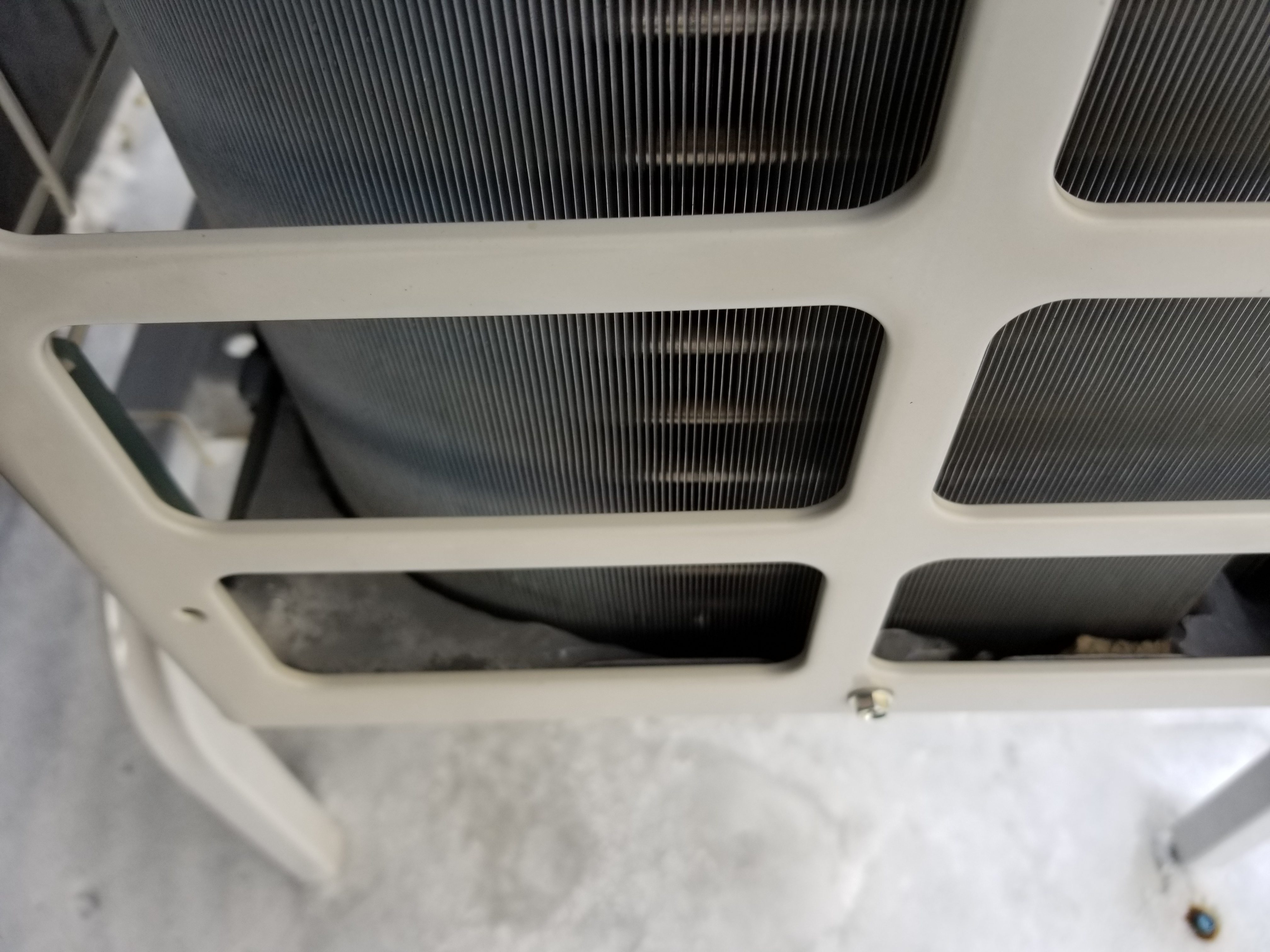
Mitsubishi Wall-mounted Heads: Beauty or Beast
I’ve read that some interior designers, and even some homeowners, have expressed aesthetic concerns about the distribution heads. If you go on design-oriented websites like Houzz you can come across some really strong negative opinions on the topic.
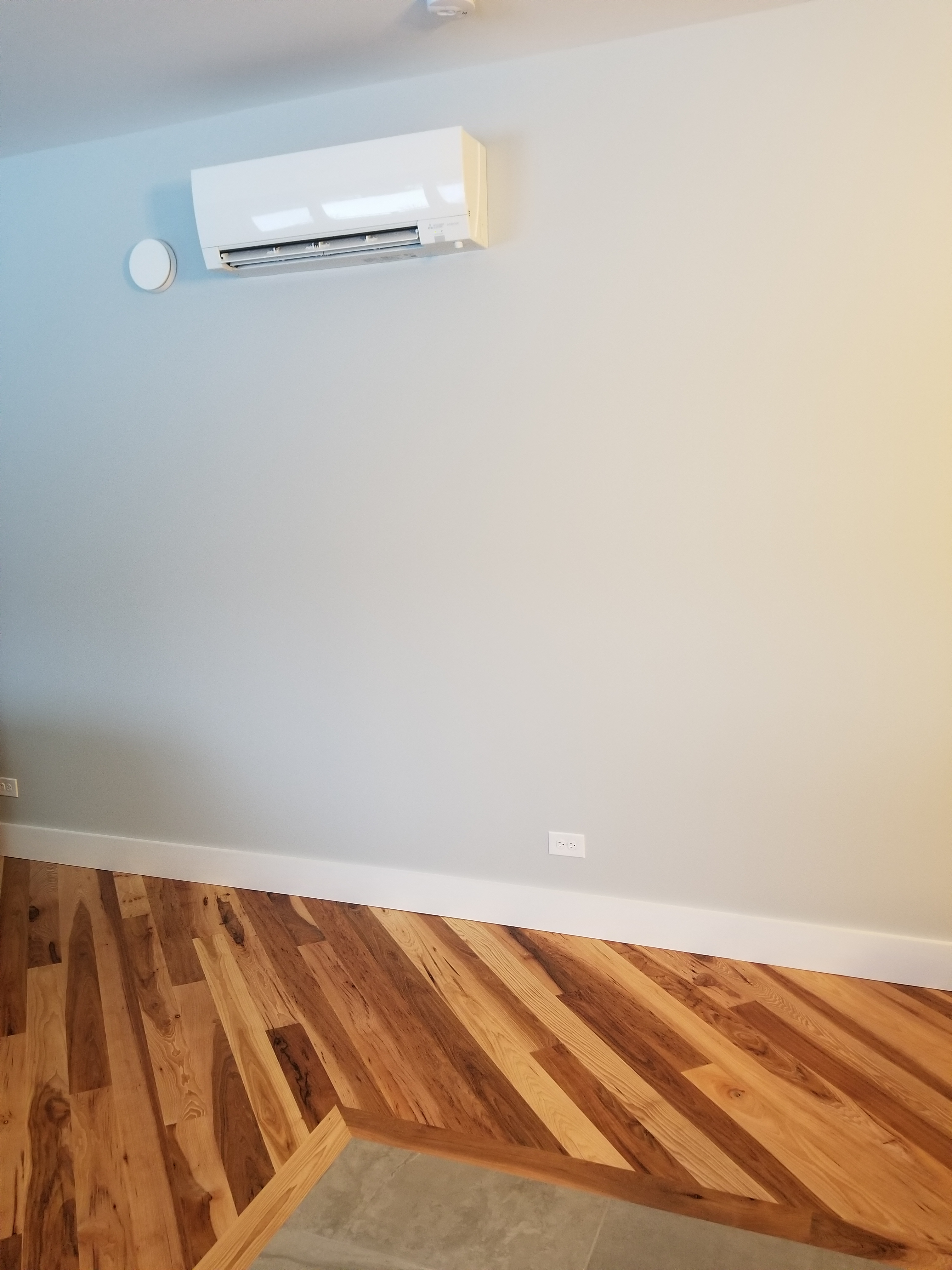
For us, they’ve never been a problem. Much like the Suntuitive glass on our west-facing windows, or even a dark or bright color on an interior accent wall, after a few days, like anything else, you just get used to it. I never found them to be ugly in the first place though.
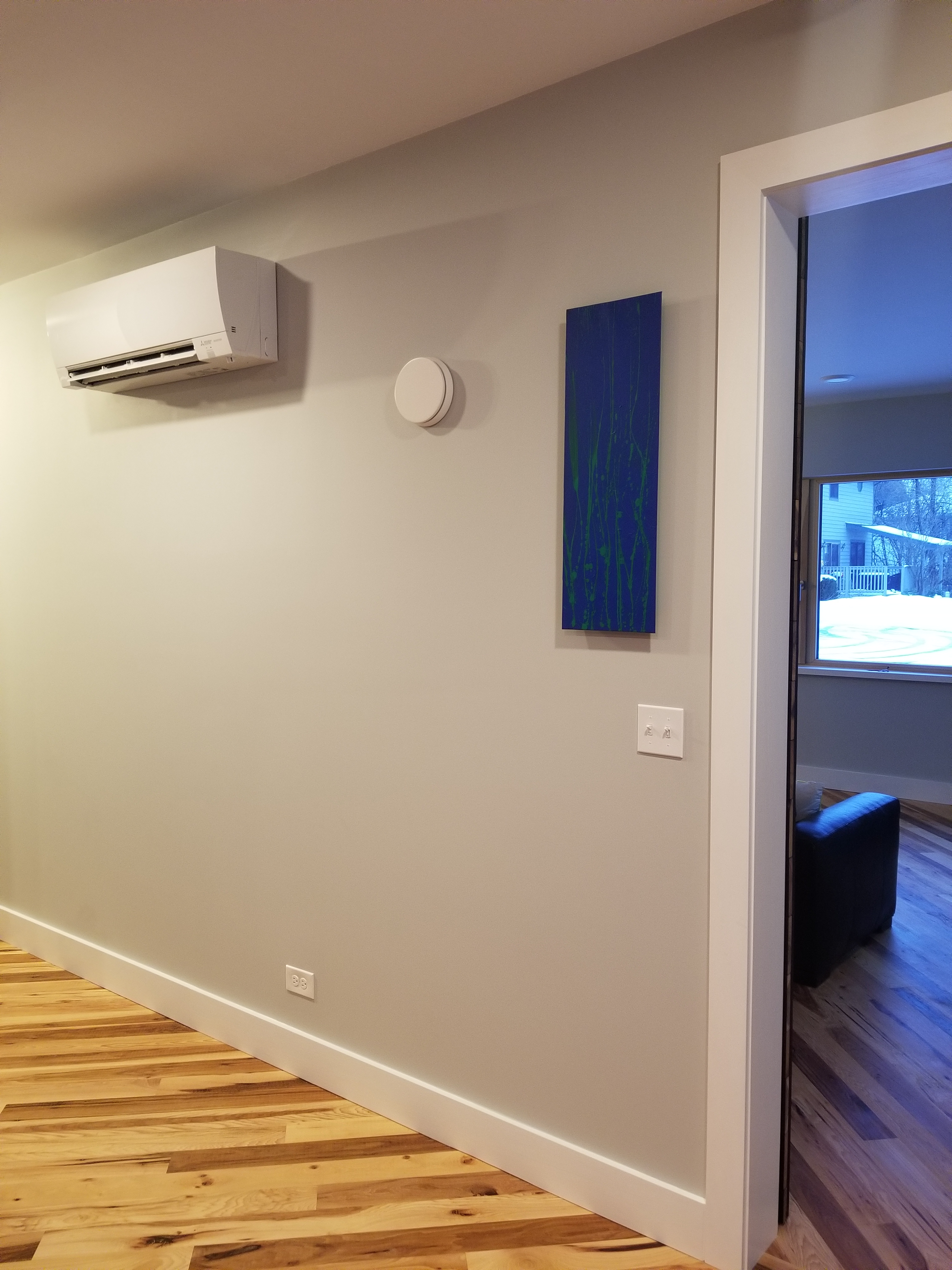
I also grew up with hydronic metal baseboards for heat, while in apartments and our first home we had the typical floor supply and wall return grilles for a gas furnace — point being, the details of any HVAC system are never completely absent from any living space. There’s always something that shows up visually and, typically, that needs to be cleaned at some point.
In addition, the Zehnder ERV and the Mitsubishi heat pumps meant we didn’t have to utilize any framed soffits or duct chases (at least in the case of our specific floor plan) in order to hide bulky runs of traditional metal ductwork, typical in most homes when using a normal furnace. Unless designed with great care, these tend to be obtrusive, taking up premium ceiling, wall, or floor space. And if randomly placed simply for the convenience of the HVAC contractor, they can be downright ugly.
In other words, it doesn’t really matter if you’re building conventionally or if you’re building a Passive House, all the details of an HVAC system — whether it’s individual components, or even how these components will be placed inside a structure — should be carefully thought through (again, ideally before construction begins) to address any performance or aesthetic concerns.
Controlling and Adjusting the System
As far as the remote controls for the individual heads, we haven’t had any issues.

For the most part, we set them to either heat or AC (roughly 70° and 75° respectively), and then forget about them.

To the extent I’ve looked through the manual, these seem straightforward, but again we haven’t really needed to do much in this regard. And when the weather is pleasant outdoors, we take every opportunity to turn off the system completely and then open windows.
Mike also explained the system could be combined with a Kumo cloud set-up, but we’ve been happy with just the hand-held remotes so far.
Routine Maintenance
And much like with the Zehnder ERV, I try to check the filters for the individual heads at least once a month (more like once a week when I was still doing interior finishes). Just as it takes much longer for the Zehnder filters to get dirty now that construction is over, the same has proven true for the blue filters in the Mitsubishi heads. It seems like about once a month is sufficient to keep up with the dust in the house.
Overall, we’ve been very happy with our HVAC set-up, including the Zehnder ERV and our Mitsubishi ductless mini split. As long as the units don’t have any durability issues, we should be happy with these systems for many years to come.

You must be logged in to post a comment.